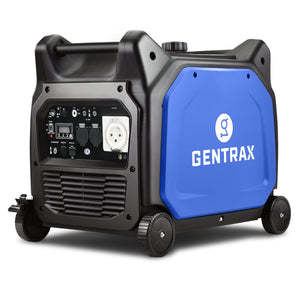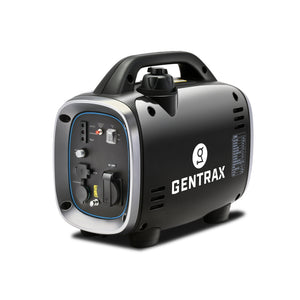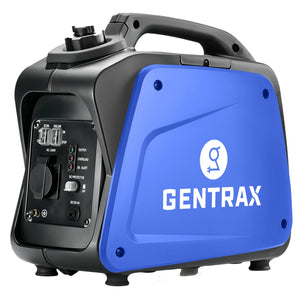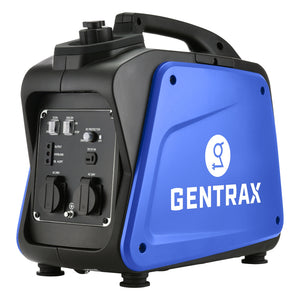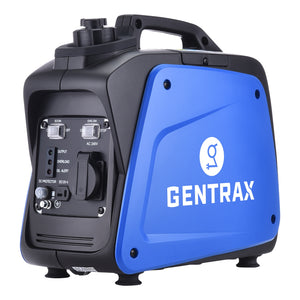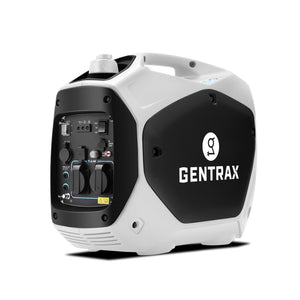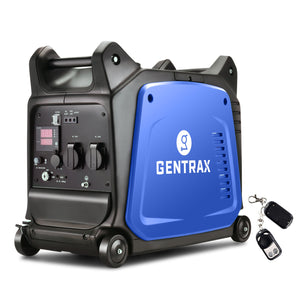Finding the Right Portable Generator
In a world that runs on electricity, having access to reliable power wherever you go is no longer a luxury—it's a necessity. From weekend camping getaways and caravanning holidays to the peace of mind of having backup power at home, a portable inverter generator is your key to energy independence and convenience. These versatile devices are central to modern power solutions, offering the freedom to run appliances, charge devices, and keep essentials operating far from the nearest electrical outlet.
However, with so many options available, the challenge lies in choosing the right one. This guide is designed to demystify the selection process, helping you understand the crucial features and types of generators, with a special focus on advanced models like Gentrax inverter generators. We will walk you through matching a generator to your specific needs, ensuring you have dependable power for any outdoor activity or as a robust backup when you need it most.
Understanding Portable Generators: What You Need to Know
Before selecting a generator, it's essential to grasp the fundamentals of how they work and the different options available. At its core, a portable generator is a machine that converts mechanical energy, typically from a fuel-powered engine, into electrical energy, providing on-demand power for recreational, backup, or worksite applications. There are several types of portable generators, but the most significant distinction is between conventional and inverter models. A conventional petrol generator or a diesel generator produces AC power directly, making it suitable for heavy-duty tools but less ideal for delicate electronics. In contrast, an inverter generator is a more sophisticated portable electric generator that produces clean, stable "pure sine wave" power.
This is achieved through a multi-step process where the initial AC power is converted to DC and then inverted back to a high-quality AC output. This technology is not only safer for laptops and smartphones but also results in a quieter and more fuel-efficient unit, often featuring an "eco-mode" to further conserve fuel. Understanding power output, measured in Watts (W) or kilovolts-amperes (kVA), is equally critical. You must choose a generator with enough capacity to handle the combined wattage of your appliances, and as a general rule, it's wise to select a model with about 30% more power than you estimate you'll need to handle initial start-up surges.
Why Choose an Inverter Generator for Modern Power Needs
For the majority of contemporary power needs, the inverter generator stands out as the superior choice, engineered to meet the demands of our technology-driven lifestyles. The primary advantage lies in its ability to produce "pure sine wave" power, a clean and stable electrical current identical to that supplied by the grid. This is vital for a generator for sensitive electronics, as it prevents damage to devices like laptops, smartphones, TVs, and medical equipment, which can be harmed by the less stable output of conventional generators. This is made possible by the unique AC-DC-AC conversion process that refines the electricity. Furthermore, inverter generators are renowned for being exceptionally quiet.
A typical inverter model, like the Gentrax G3500 Inverter Generator, operates at a noise level between 50-65 decibels, as quiet as a normal conversation, whereas conventional models can exceed 80 decibels, which is as loud as a lawnmower. This makes them the ideal quiet generator for camping, residential areas, and any environment where noise is a concern. Another key benefit is fuel efficiency. A fuel-efficient generator with an "eco-mode" automatically adjusts its engine speed to match the current load, meaning it only works as hard as it needs to.
This not only significantly reduces fuel consumption and operational costs but also lowers emissions. Combined with their typically lighter, more compact design for enhanced portability, inverter generators from trusted brands embody all these benefits, offering a smarter, quieter, and more reliable power solution.
Selecting the Ideal Portable Generator: Your Buying Guide
Navigating how to choose a portable generator involves a few straightforward steps to ensure you find the perfect match for your requirements. The first and most crucial step is to calculate your power needs. Answering the question "What size generator do I need?" begins by listing all the appliances you intend to power and adding up their running wattage, paying special attention to the higher starting (or surge) wattage of items with motors like fridges or air conditioners. Applying the 30% buffer rule will give you a target capacity; for example, a simple camping setup might only require a small generator under 1000W, whereas a generator for home backup might need a 3500W generator or even a 6000W generator. Models like the Gentrax GT3500 generator are ideal for mid-range needs, offering 3.5kW max output, 3.0kW rated output, two 240V AC outlets, a DC output, and a low 62dB noise level at 7 metres. It also comes with a 12-month warranty. For higher power demands, the Gentrax GTX6600 generator is a better fit.
Secondly, consider your primary use case. For a camping generator or caravan generator, priorities are portability, low noise, and efficiency, making a small generator like the Gentrax GT2000 ideal. The Gentrax GT2000 Inverter Generator offers a maximum output of 2.0 kW and a rated output of 1.7 kW, operating at a noise level of 60 dB (at 7m). It features two 240V AC outlets and one DC output, all within compact dimensions of L525 x W282 x H458 mm and a weight of 18.5 kg, backed by a 12-month warranty. For home backup, the focus shifts to higher output and reliability. For work sites, durability is key.
Thirdly, assess the portable generator features to look for. Check the decibel (dB) rating for noise level, the fuel tank size for run time, and the number and type of outlets (USB, 12V DC, 240V AC). Portability features like weight, handles, and wheels are also important. Finally, consider your budget. While inverter generators may have a higher initial cost, their fuel efficiency and longevity offer better long-term value, and exploring a trusted range like Gentrax ensures you find a quality unit that meets crucial safety standards. Compliance with regulations like AS/NZS 3010 is essential for electrical safety, giving you certified peace of mind that your generator is fit for use in Australia. Our generator Buying Guide cuts out the guesswork by explaining what you need to take into consideration. Check it out now.
Top Uses: What Can a Portable Generator Power?
Understanding what a portable generator can power helps to illustrate its immense utility across various scenarios. For generator camping trips and outdoor adventures, a small generator for camping, such as a Gentrax 800W to 2000W model, can comfortably run LED lights, charge phones and laptops, power a portable fridge, and operate a small electric cooktop, transforming a basic campsite into a powered haven. In a caravan, a slightly larger generator in the 2200W to 3500W range can handle more demanding comforts like a small air conditioner, a microwave, and a television, ensuring all the conveniences of home while on the road.
During a power cut at home, a reliable generator becomes a lifeline, capable of running essential appliances. A 3500W model can typically power a large refrigerator/freezer, lights in several rooms, a fan, and critical medical equipment simultaneously. For those on a worksite or tackling DIY projects, a generator provides the necessary grunt for power tools like drills, circular saws, and grinders. Even social events and outdoor gatherings benefit from portable power, running sound systems, decorative lighting, and food warmers with ease. In every case, the key is to match the generator's capacity to the specific wattage demands of the appliances you plan to use.
Essential Safety and Maintenance for Your Generator
To ensure the longevity of your generator and, more importantly, your safety, adhering to essential portable generator safety guidelines and a regular maintenance schedule is non-negotiable. The most critical safety rule is ventilation: never operate a generator indoors, in a garage, shed, or any enclosed space. Generators produce carbon monoxide (CO)—an invisible, odourless, and deadly gas. This is the single most important safety rule, as improper ventilation can be fatal. Always run your generator outdoors, at least 5-7 metres away from windows, doors, and vents. When refuelling, always turn the engine off and let it cool down completely to prevent fire hazards.
Electrical safety is also paramount; keep the generator dry, use heavy-duty extension cords rated for outdoor use, and ensure proper earthing if required by the manufacturer. For home connections, never plug the generator directly into a wall outlet (a dangerous practice known as back-feeding); instead, use a manual transfer switch installed by a licensed electrician. Following some basic portable generator maintenance tips will keep your unit in prime condition. Regularly check the oil levels, clean or replace the air filter as needed, and inspect the spark plug. Use fresh fuel, and for long-term storage, consider adding a fuel stabiliser. Storing it in a clean, dry place during the off-season will prevent damage and ensure it's ready to go when you need it next. Always refer to the manufacturer's manual for specific advice tailored to your model.
Powering Your Adventures and Needs
Ultimately, selecting the right model from the vast range of portable generators available is about empowering your lifestyle, whether that means ensuring comfort on an outdoor adventure or providing security during a power outage. By carefully assessing your power requirements, understanding the significant benefits of an inverter generator—namely, its clean power, quiet generator option, and fuel efficiency—and matching the features to your primary use case, you can make a confident and informed decision. A well-chosen portable generator is more than just a piece of equipment; it is a source of freedom, reliability, and peace of mind. Armed with this knowledge, you are now ready to find your perfect power solution. Explore the comprehensive portable generator range now to compare models and choose the perfect power solution for your needs.
For related articles: Buying a Portable Generator: 10 Must-Know Tips
Frequently Asked Questions
-
How does a portable generator work?
A portable generator uses an internal combustion engine to turn an alternator, which converts the mechanical energy from the engine into electrical energy, like the Gentrax GT2200 Pro Inverter Generator. Inverter models further refine this electricity by converting it from AC to DC and back to a cleaner, more stable AC "pure sine wave" output, which is safer for modern electronics.
-
What is the best portable generator for home use?
The best generator for home use depends on your power needs. Typically, inverter generators with an output between 3000W and 6500W, like the Gentrax GT3500 or GTX6600 models, are excellent choices for running essential appliances such as a refrigerator, lights, and medical devices during a power cut.
-
What size generator do I need for camping?
For most camping applications, a smaller and silent inverter generator with an output of 800W to 2200W is ideal. This size is perfect for powering lights, charging devices like phones and laptops, and running small appliances. Models like the Gentrax GT2000 are popular for this purpose.
-
How quiet are Gentrax inverter generators?
Gentrax inverter generators are designed for quiet operation, typically producing noise levels between 50 and 65 decibels when measured from a distance of 7 metres. This is comparable to the volume of a normal conversation, making them ideal for use in campsites and noise-sensitive areas.
-
Are inverter generators like Gentrax good for sensitive electronics?
Yes. Gentrax inverter generators produce a "pure sine wave" output, which is a stable and clean form of electricity. This makes them perfectly safe for powering sensitive electronics such as laptops, smartphones, drones, cameras, and TVs without the risk of damage.
-
How much is a portable generator?
The price of a portable generator varies widely based on its type (inverter vs. conventional), power output (wattage), and features. Inverter generators may have a higher upfront cost, but their superior fuel efficiency, quieter operation, and cleaner power often provide better long-term value.
-
What's the difference between an inverter generator and a conventional one?
The main differences are in the quality of power, noise, and efficiency. Inverter generators produce cleaner "pure sine wave" power safe for electronics, are significantly quieter, and are more fuel-efficient. Conventional generators are generally louder and produce power that is better suited for robust power tools and less sensitive equipment
-
How long will a Gentrax generator run on a tank of fuel?
The run time depends on the specific model, the size of its fuel tank, and the electrical load being drawn. Thanks to their "eco-mode" feature, Gentrax inverter generators are highly fuel efficient and can often run for many hours on a single tank. Always check the product specifications for exact run times.
-
What maintenance does a portable generator require?
Basic maintenance includes regularly checking the oil level, cleaning or replacing the air filter, inspecting the spark plug for wear, and always using fresh fuel. It is also important to store the generator correctly when not in use.
-
Can I use a portable generator in the rain?
It is strongly advised not to use a portable generator in the rain or wet conditions. Water and electricity are a dangerous combination. If you must operate it in poor weather, it should be protected by a purpose-built generator tent or a well-ventilated, waterproof canopy that keeps it dry without obstructing airflow.
-
What is "eco-mode" on an inverter generator?
"Eco-mode" is a smart feature that automatically adjusts the generator's engine speed to match the power demand of the connected load. When the load is low, the engine runs slower, which saves a significant amount of fuel, reduces noise, and lowers emissions.
-
Do I need a special switch to connect a generator to my house?
Yes. To safely connect a portable generator to your home's electrical system, you must use a manual transfer switch installed by a licensed electrician. This device prevents dangerous "back-feeding," which can electrocute utility workers and damage your generator and home appliances.
Frequently Asked Questions
- How does a portable generator work?
- What is the best portable generator for home use?
- What is "eco-mode" on an inverter generator?
- Do I need a special switch to connect a generator to my house?
- What size generator do I need for camping?
- How quiet are Gentrax inverter generators?
- Are inverter generators like Gentrax good for sensitive electronics?
- How much is a portable generator?
- What's the difference between an inverter generator and a conventional one?
- How long will a Gentrax generator run on a tank of fuel?
- What maintenance does a portable generator require?
- Can I use a portable generator in the rain?
